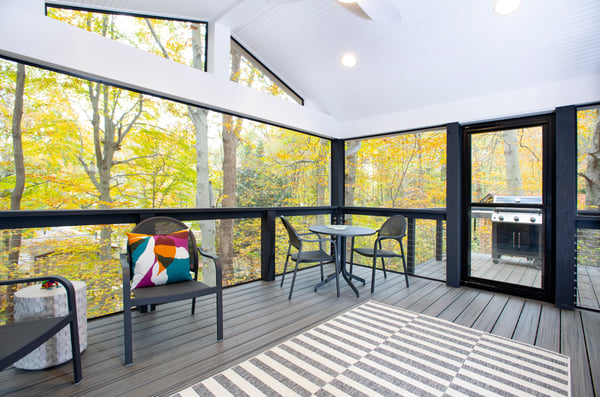10 Tips for Childproofing a Screened Porch
There comes a time in every toddler's life to learn about pain. Falling hurts, badly. And, as parents of little ones ourselves, we are all too familiar with our youngsters' propensity for getting into mischief, scrapes, and scuffles. Prevent your screened-in porch or deck from becoming a part of a life lesson by practicing the ensuing child-friendly safety precautions.
- Install a childproof door. A sturdy storm door with an adequate lock will prevent curious tykes from crawling out of the house. In addition to the obvious problems this solves, a childproofed door will keep barbecue equipment, pools, and passing vehicles out of reach from tiny wondering legs.
We recommend storm doors made with powder-coated aluminum and a hinge guard to prevent doors from accidentally shutting on poorly placed fingers. It is also important to purchase a door with a plexiglass insert covering as a bottom window as screen doors are easily ripped by pets and children alike, who are prone to scratching at, leaning on, or pushing into door screens. - Verify your electrical outlets are up to code. Northern Virginia building code dictates that all screen rooms must have at least one electrical outlet. These fixtures are required to be weatherproof, tamper proof, and housed in protective watertight casings.
- Do you have regulation railings installed? Local building codes contain hyper-specific rules detailing what makes railing systems safe for children and adults alike. At a minimum, this entails having post gaps that are no greater than 4" wide to prevent unwanted body parts from slipping through or getting stuck in the railings.
After installing a railing system, your decking contractor must submit an ICC-ES Evaluation Report to verify code compliance and the strength of their design.

- Install synthetic decking. Splintering can become a significant problem when children and adults walk barefoot on aging hardwood decking. Opting to replace an existing deck or construct a new deck with a synthetic decking material like Zuri or Trex will eliminate the threat of splinters entirely. Avoid preservative-treated wood, which can be toxic for children and pets.
- Block stairways. Prevent nasty trips and falls by blocking the stairways of your screen room with a reinforced safety gate fastened to sturdy posts.
- Install proper barriers on fireplaces. If there is a fireplace or fire pit inside of your screened-in porch, be sure to fence off the immediate area with a sturdy screen or fence. Avoid free-standing screens, which children can easily pull down or fall into.
- Stick to child-friendly furniture and appliances. Choose furniture that doesn’t fold up or tip over easily, and always check to see if any painted pieces are nontoxic. Keep barbecue grills, starter fluid, propane tanks, and other cooking equipment stowed safely in a location children cannot access.
- Be cognizant of your furniture placement. Benches and other outdoor furniture can become dangerous if placed against the railings of your screened room, as young children may climb onto these objects and scale the porch railings. Obviously, this is particularly dangerous for second-story and elevated screen porches.
- Have an eye for quality control. Inspect decks and deck boards routinely for loose nails, broken boards, and chipped or peeling paint.
- Consult with your contractor. A contractor in Maryland or Virginia can inspect your existing deck and patio design for safety and help you make modifications to keep your youngest family members protected.



